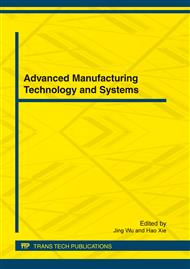[1]
P. Poizot, S. Laruelle, S. Grugeon, L. Dupont and J. M. Taracon: Nature, Vol. 407 (2000), p.496.
Google Scholar
[2]
R.V. Kumar, Y. Diamant and A. Gedanken: Chem. Mater., Vol. 12 (2000), p.2301.
Google Scholar
[3]
H. Cao and S. L. Suib: J. Am. Chem. Soc., Vol. 116 (1994), p.5334.
Google Scholar
[4]
B. Ao, L. Kummerl and D. Haarer: Adv. Mater., Vol. 7 (1995), p.495.
Google Scholar
[5]
M. Singhal, P. Chhabra, P. Kang and D. O. Shah: Mater. Res. Bull., Vol. 32 (1997), p.233.
Google Scholar
[6]
Y. Jiang, S. Decker, C. Mohs and K. J. Klabunde: J. Catal., Vol. 180 (1998), p.24.
Google Scholar
[7]
T. Ishihara, M. Higuchi, T. Takagi, M. Ito, H. Nishiguchi and T. Takita: J. Mater. Chem., Vol. 8 (1998), p.2037.
Google Scholar
[8]
W. Zhang, S. Ding, Z. Yang, A. Liu, Y. Qian, S. Tang and S. Yang: J. Cryst. Growth, Vol. 291 (2006), p.479.
Google Scholar
[9]
C. L. Zhu, C. N. Chen, L. Y. Hao, Y. Hu and Z. Y. Chen: J. Cryst. Growth, Vol. 263 (2004), p.473.
Google Scholar
[10]
W. Jisen, Y. Jinkai, S. Jinquan and B. Ying: Mater. Des., Vol. 25 (2004), p.625.
Google Scholar
[11]
M. Kaur, K. P. Muthe, S. K. Despande, S. Choudhury, J. B. Singh, N. Verma, S. K. Gupta and J. V. Yakhmi: J. Cryst. Growth, Vol. 289 (2006), p.670.
DOI: 10.1016/j.jcrysgro.2005.11.111
Google Scholar
[12]
X. Song, H. Yu and S. Sun: J. Colloid Interf. Sci., Vol. 289 (2006), p.588.
Google Scholar
[13]
R. V. Kumar, Y. Diamant and A. Gedanken: Chem. Mater., Vol. 12 (2000), p.2301.
Google Scholar
[14]
A. A. Eliseev, A. V. Lukashin, A. A. Vertegel, L. I. Heifets, A. I. Zhirov and Y. D. Tretyakov: Mater. Res. Innovations, Vol. 3 (2000), p.308.
Google Scholar
[15]
J. F. Xu, W. Ji, Z. X. Shen, S. H. Tang, X. R. Ye, D. Z. Jia and X. Q. Xin: J. Solid State Chem., Vol. 147 (2000), p.516.
Google Scholar
[16]
K. Borgohain, J. B. Singh, M. V. Rama Rao, T. Shripathi and S. Mahamuni: Phys. Rev., Vol. 61 (2000), p.11093.
DOI: 10.1103/physrevb.61.11093
Google Scholar
[17]
J. Q. Yu, Z. Xu and D. Z. Jia: Chin. J. Functional Mater. Instrum., Vol. 5 (1999), p.267.
Google Scholar
[18]
S. Nakao, M. Ikeyama, T. Mizota, P. Jin, M. Tazawa, Y. Miyagawa, S. Miyagawa, S. Wang and L. Wang: Rep. Res. Cent. Ion Beam Technol., Hosei Univ., Vol.18 (Suppl.) (2000), p.153.
Google Scholar


